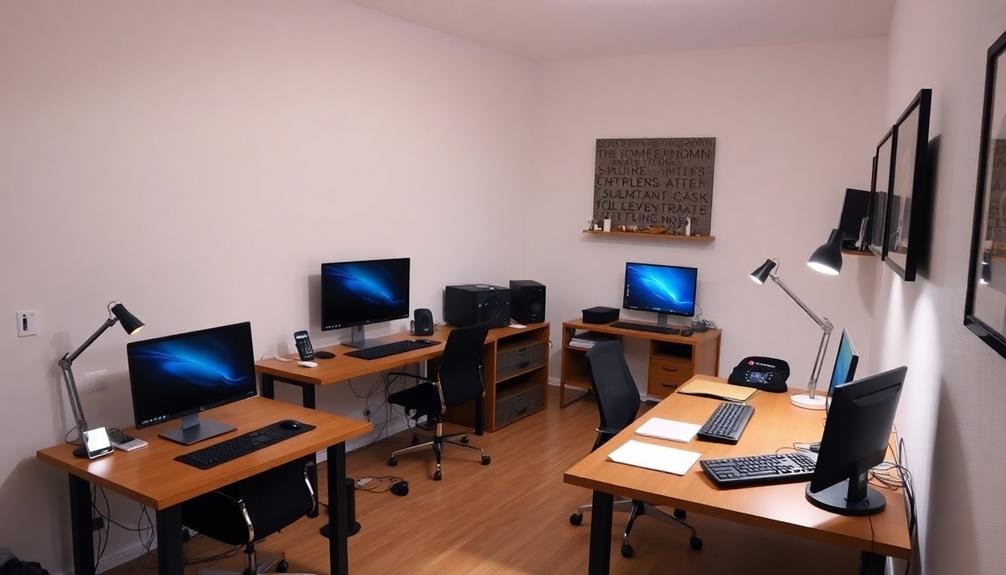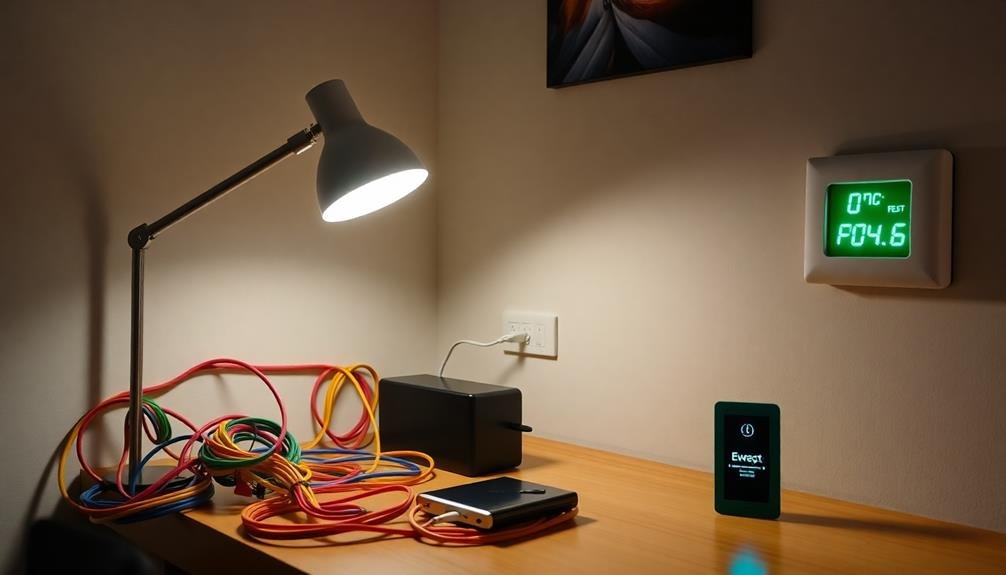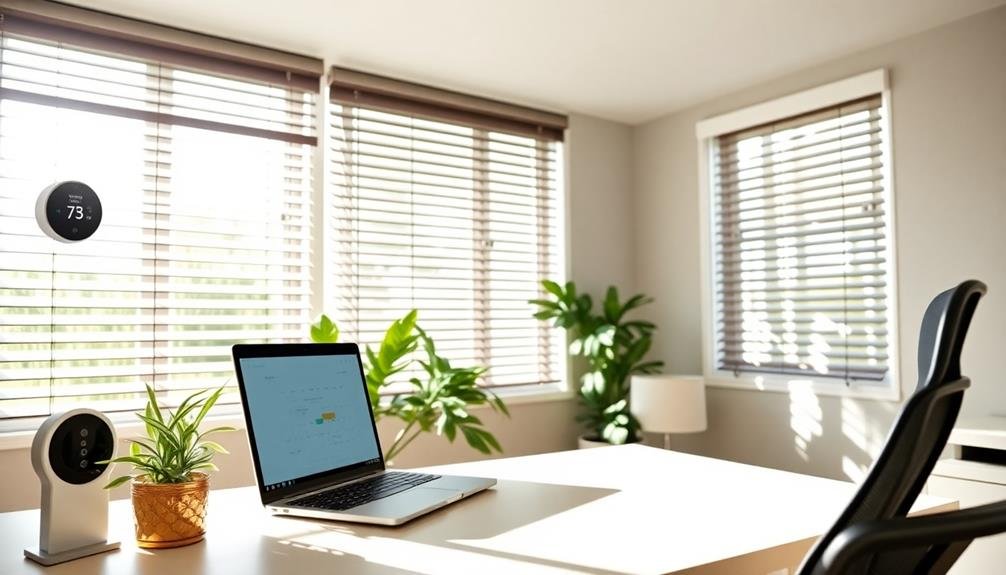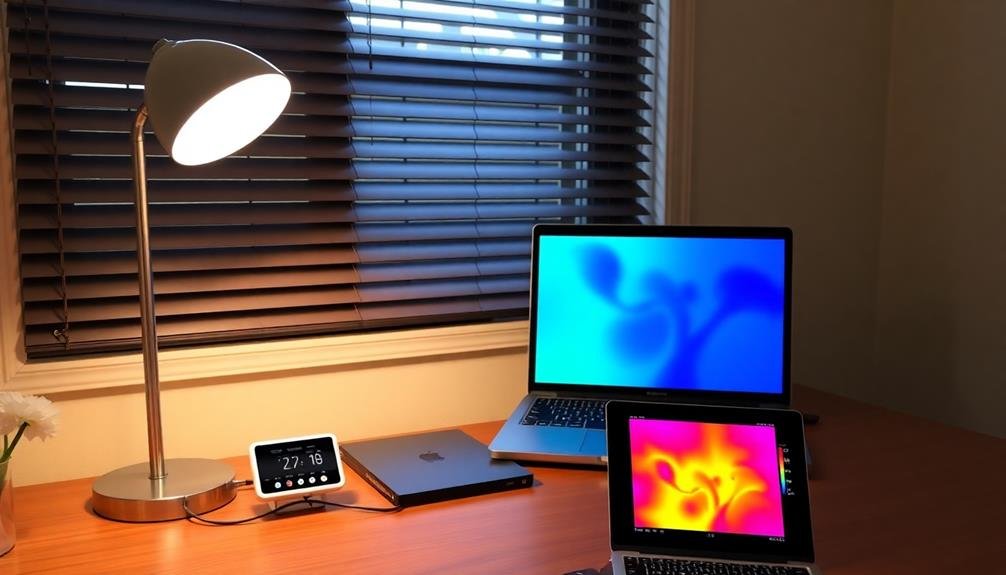Smart cable management can greatly reduce your home office energy bills by tackling phantom energy drain. By organizing cables and using power strips or smart plugs, you'll easily identify and control energy-hungry devices. This approach allows you to unplug or switch off equipment when not in use, preventing unnecessary power consumption. Proper cable organization also helps you maintain and clean your devices more efficiently, ensuring they operate at peak performance. Additionally, implementing long-term strategies like investing in energy-efficient products and scheduling power-down times can lead to substantial savings. Discover how these simple techniques can transform your home office's energy consumption.
Understanding Phantom Energy Drain

Phantom energy drain, also known as standby power, is the electricity consumed by electronic devices when they're turned off or in standby mode. You might be surprised to learn that many of your home office electronics continue to draw power even when you're not using them. This silent energy consumption can account for up to 10% of your household's electricity usage.
Common culprits include computer monitors, printers, speakers, and chargers. These devices often have LED lights, digital clocks, or remote control sensors that remain active, drawing small amounts of power continuously. While the energy consumed by a single device may seem negligible, the cumulative effect across multiple gadgets can greatly impact your energy bill.
To combat phantom energy drain, you'll need to be proactive. Unplug devices when they're not in use or use power strips with on/off switches to cut power completely. Smart power strips can automatically detect when devices enter standby mode and cut off their power supply.
Identifying Energy-Hungry Devices
Three key steps can help you identify energy-hungry devices in your home office.
First, conduct an energy audit using a power meter. Plug each device into the meter and monitor its energy consumption over time. This will reveal which items are drawing the most power, even when not in use.
Second, review your electricity bills and look for patterns. If you notice sudden spikes in energy usage, it could indicate a new energy-hungry device or a malfunction in existing equipment. Compare your bills over several months to spot trends and anomalies.
Lastly, be aware of common culprits. Desktop computers, printers, and older devices typically consume more energy than laptops and newer, energy-efficient models.
Large displays, space heaters, and air conditioners are also notorious for high energy consumption.
Don't forget about less obvious offenders like coffee makers, phone chargers, and smart speakers that remain plugged in constantly.
Effective Cable Organization Techniques

Once you've identified your energy-hungry devices, it's time to tackle the chaos of cables they create. Effective cable organization not only improves aesthetics but also enhances energy efficiency. Start by unplugging all devices and laying out cables to assess their length and condition. Replace any frayed or damaged cables to prevent energy leakage.
Use cable management solutions like zip ties, cable clips, or cable sleeves to bundle cords together. This reduces clutter and makes it easier to identify and access specific cables when needed. Label each cable at both ends for quick identification, saving time and energy when troubleshooting or rearranging your setup.
Consider investing in a cable management box to hide power strips and excess cable length. This not only looks neater but also protects against dust accumulation, which can affect device performance and energy consumption.
| Technique | Benefits | Implementation |
|---|---|---|
| Cable Ties | Reduces tangling | Group similar cables |
| Labeling | Easy identification | Use colored tags or tape |
| Cable Box | Hides clutter | Store power strips inside |
Power Strips and Smart Plugs
Building on your cable organization efforts, power strips and smart plugs play an essential role in managing energy consumption.
These devices not only help you declutter your workspace but also give you greater control over your energy usage.
Power strips allow you to connect multiple devices to a single outlet, reducing the need for individual wall plugs.
Look for models with surge protection to safeguard your electronics from power spikes. Some advanced power strips feature individual switches for each outlet, letting you easily turn off specific devices without unplugging them.
Smart plugs take energy management a step further.
You can control these Wi-Fi-enabled devices remotely through your smartphone or voice assistant.
Set schedules to automatically turn off equipment when it's not in use, such as during nights or weekends.
Many smart plugs also offer energy monitoring features, helping you identify power-hungry devices and adjust your usage accordingly.
Cable Management for Multiple Workstations

For offices or shared spaces with multiple workstations, effective cable management becomes even more essential. You'll need to organize cables for each station while maintaining a clean, efficient layout.
Start by assigning dedicated power strips to each workstation, keeping them easily accessible but out of sight. Use color-coded labels or tags to identify which cables belong to each station, making troubleshooting and reorganization simpler.
Implement a centralized power management system to control all workstations from a single point. This allows you to easily power down unused stations, reducing phantom energy consumption. Consider installing smart power strips that can be controlled remotely or programmed to shut off during non-working hours.
Utilize cable trays or J-channels to route cables neatly along walls or under desks, keeping them off the floor and reducing tripping hazards. For workstations that require frequent reconfiguration, invest in modular cable management systems that can adapt to changing needs.
Don't forget to leave some slack in the cables to allow for movement and prevent strain on connections. Regularly inspect and maintain your cable management system to guarantee peak performance and energy efficiency across all workstations.
Long-Term Energy Savings Strategies
While effective cable management can lead to immediate energy savings, implementing long-term strategies can greatly reduce your power consumption over time.
You'll want to focus on both your equipment choices and usage habits to maximize energy efficiency in your home office.
Start by investing in energy-efficient devices. Look for ENERGY STAR certified products when upgrading your computer, monitor, printer, and other office equipment.
These items consume less power during operation and standby modes, leading to significant savings over their lifespans.
Next, consider implementing smart power strips and automated systems. These tools can help you easily control and monitor your energy usage, making sure devices aren't drawing unnecessary power when not in use.
To further enhance your energy savings, try:
- Setting up a schedule for powering down equipment during non-work hours
- Utilizing natural light and LED bulbs to reduce lighting costs
- Regularly maintaining and cleaning your devices to guarantee peak performance
Frequently Asked Questions
How Does Cable Management Affect Wi-Fi Signal Strength?
Cable management can improve your Wi-Fi signal strength by reducing interference. When you organize cables, you'll prevent them from tangling and crossing, which can disrupt wireless signals. Proper cable routing also helps minimize electromagnetic interference between devices.
Can Proper Cable Organization Reduce Fire Hazards in the Home Office?
Yes, proper cable organization can reduce fire hazards in your home office. You'll prevent overheating and short circuits by keeping cables untangled and away from heat sources. It also limits dust accumulation, which can cause electrical fires.
Are There Eco-Friendly Cable Management Products Available?
Yes, you'll find numerous eco-friendly cable management options. Look for products made from recycled materials, biodegradable plastics, or sustainable bamboo. You can also use reusable cable ties or cloth wraps to reduce waste in your home office.
How Often Should I Update My Cable Management System?
You should update your cable management system whenever you add or remove devices, or at least annually. It's important to regularly assess your setup, eliminate unused cables, and optimize your arrangement for efficiency and safety.
Can Cable Management Improve the Resale Value of My Home Office Equipment?
Yes, it can. You'll enhance your equipment's appeal by keeping cables tidy. Buyers appreciate well-organized setups, as they're easier to move and set up. It shows you've maintained your gear, potentially increasing its perceived value.
In Summary
You've now got the tools to tackle phantom energy drain in your home office. By organizing your cables, using smart plugs, and identifying power-hungry devices, you'll cut your energy bills considerably. Remember, it's not just about tidiness; it's about saving money and reducing your carbon footprint. Keep refining your cable management strategy, and you'll see long-term benefits. Your wallet and the planet will thank you for your smart energy choices.




Leave a Reply